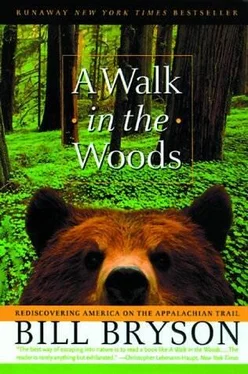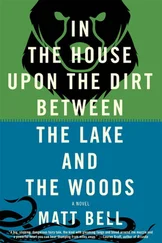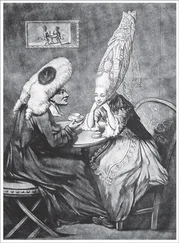Bill Bryson - A Walk In The Woods
Здесь есть возможность читать онлайн «Bill Bryson - A Walk In The Woods» весь текст электронной книги совершенно бесплатно (целиком полную версию без сокращений). В некоторых случаях можно слушать аудио, скачать через торрент в формате fb2 и присутствует краткое содержание. Жанр: Современная проза, на английском языке. Описание произведения, (предисловие) а так же отзывы посетителей доступны на портале библиотеки ЛибКат.
- Название:A Walk In The Woods
- Автор:
- Жанр:
- Год:неизвестен
- ISBN:нет данных
- Рейтинг книги:4 / 5. Голосов: 1
-
Избранное:Добавить в избранное
- Отзывы:
-
Ваша оценка:
- 80
- 1
- 2
- 3
- 4
- 5
A Walk In The Woods: краткое содержание, описание и аннотация
Предлагаем к чтению аннотацию, описание, краткое содержание или предисловие (зависит от того, что написал сам автор книги «A Walk In The Woods»). Если вы не нашли необходимую информацию о книге — напишите в комментариях, мы постараемся отыскать её.
A Walk In The Woods — читать онлайн бесплатно полную книгу (весь текст) целиком
Ниже представлен текст книги, разбитый по страницам. Система сохранения места последней прочитанной страницы, позволяет с удобством читать онлайн бесплатно книгу «A Walk In The Woods», без необходимости каждый раз заново искать на чём Вы остановились. Поставьте закладку, и сможете в любой момент перейти на страницу, на которой закончили чтение.
Интервал:
Закладка:
These people covered astonishing sweeps, for considerable periods. One of the younger Bartram’s expeditions lasted over five years and plunged him so deeply into the woods that he was long given up for lost; when he emerged, he discovered that America had been at war with Britain for a year and he had lost his patrons. Michaux’s voyages took him from Florida to Hudson’s Bay; the heroic Nuttall ventured as far as the shores of Lake Superior, going much of the way on foot for want of funds.
They often collected in prodigious, not to say rapacious, quantities. Lyon pulled 3,600 Magnolia macrophylla saplings from a single hillside, and thousands of plants more, including a pretty red thing that left him in a fevered delirium and covered “almost in one continued blister all over” his body; he had found, it turned out, poison sumac. In 1765, John Bartram discovered a particularly lovely camellia, Franklinia altamaha; already rare, it was hunted to extinction in just twenty-five years. Today it survives only in cultivation-thanks entirely to Bartram. Rafinesque-Schmaltz, meanwhile, spent seven years wandering through the Appalachians, didn’t discover much, but brought in 50,000 seeds and cuttings.
How they managed it is a wonder. Every plant had to be recorded and identified, its seeds collected or a cutting taken; if the latter, it had to be potted up in stiff paper or sailcloth, kept watered and tended, and somehow transported through a trackless wilderness to civilization. The privations and perils were constant and exhausting. Bears, snakes, and panthers abounded. Michaux’s son was severely mauled on one expedition when a bear charged him from the trees. (Black bears seem to have been notably more ferocious in former times; nearly every journal has accounts of sudden, unprovoked attacks. It seems altogether likely that eastern bears have become more retiring because they have learned to associate humans with guns.) Indians, too, were commonly hostile-though just as often bemused at finding European gentlemen carefully collecting and taking away plants that grew in natural abundance-and then there were all the diseases of the woods, like malaria and yellow fever. “I can’t find one [friend] that will bear the fatigue to accompany me in my peregrinations,” John Bartram complained wearily in a letter to his English patron. Hardly surprising.
But evidently it was worth it. A single, particularly valued seed could fetch up to five guineas. On one trip, John Lyon cleared £900 after expenses, a considerable fortune, then returned the next year and made nearly as much again. Fraser made one long trip under the sponsorship of Catherine the Great of Russia and emerged from the wilderness only to find that there was a new czar who had no interest in plants, thought he was mad, and refused to honor his contract. So Fraser took everything to chelsea, where he had a little nursery, and made a good living selling azaleas, rhododendrons, and magnolias to the English gentry.
Others did it for the simple joy of finding something new-none more admirably than Thomas Nuttall, a bright but unschooled journeyman printer from Liverpool who came to America in 1808 and discovered an unexpected passion for plants. He undertook two long expeditions, which he paid for out of his own pocket, made many important discoveries, and generously gave to the Liverpool Botanic Gardens plants that might have made him rich. In just nine years, from a base of zero, he became the leading authority on American plants. In 1817, he produced (literally, for he not only wrote the text but set most of the type himself) the seminal Genera of North American Plants, which stood for the better part of a century as the principal encyclopedia of American botany. Four years later he was named curator of the Botanic Garden at Harvard University, a position he held with distinction for a dozen years, and somehow also found time to become a leading authority on birds, producing a celebrated text on American ornithology in 1832. He was, by all accounts, a kindly man who gained the esteem of everyone who met him. Stories don’t get a great deal better than that.
Already in Nuttall’s day the woods were being transformed. The panthers, elk, and timberwolves were being driven to extinction, the beaver and bear nearly so. The great first-growth white pines of the north woods, some of them 220 feet high (that’s the height of a twenty-story building), had mostly been felled to make ships’ masts or simply cleared away for farmland, and nearly all the rest would go before the century was out. Everywhere, there was a kind of recklessness borne of a sense that the American woods was effectively inexhaustible. Two-hundred-year-old pecan trees were commonly chopped down just to make it easier to harvest the nuts on their topmost branches. With each passing year the character of the woods changed perceptibly. But until quite recent times-painfully recent times-one thing remained in abundance that preserved the primeval super-Eden feel of the original forest: the massively graceful American chestnut.
There has never been a tree like it. Rising a hundred feet from the forest floor, its soaring boughs spread out in a canopy of incomparable lushness, an acre of leaves per tree, a million or so in all. Though only half the height of the tallest eastern pines, the chestnut had a weight and mass and symmetry that put it in another league. At ground level, a full-sized tree would be ten feet through its bole, more than twenty feet around. I have seen a photograph, taken at the start of this century, of people picnicking in a grove of chestnuts not far from where Katz and I now hiked, in an area known as the Jefferson National Forest. It is a happy Sunday party, all the picnickers in heavy clothes, the ladies with clasped parasols, the men with bowler hats and walrus moustaches, all handsomely arrayed on a blanket in a clearing, against a backdrop of steeply slanting shafts of light and trees of unbelievable grandeur. The people are so tiny, so preposterously out of scale to the trees around them, as to make you wonder for a moment if the picture has been manipulated as a kind of joke, like those old postcards that show watermelons as big as barns or an ear of corn that entirely fills a wagon under the droll legend“A TYPICAL IOWA FARM SCENE.” But this is simply the way it was-the way it was over tens of thousands of square miles of hill and cove, from the Carolinas to New England. And it is all gone now.
In 1904, a keeper at the Bronx Zoo in New York noticed that the zoo’s handsome chestnuts had become covered in small orange cankers of an unfamiliar type. Within days they began to sicken and die. By the time scientists identified the source as an Asian fungus called Endothia parasitica, probably introduced with a shipment of trees or infected lumber from the Orient, the chestnuts were dead and the fungus had escaped into the great sprawl of the Appalachians, where one tree in every four was a chestnut.
For all its mass, a tree is a remarkably delicate thing. All of its internal life exists within three paper-thin layers of tissue-the phloem, xylem, and cambium-just beneath the bark, which together form a moist sleeve around the dead heartwood. However tall it grows, a tree is just a few pounds of living cells thinly spread between roots and leaves. These three diligent layers of cells perform all the intricate science and engineering needed to keep a tree alive, and the efficiency with which they do it is one of the wonders of life. Without noise or fuss, every tree in a forest lifts massive volumes of water-several hundred gallons in the case of a large tree on a hot day-from its roots to its leaves, where it is returned to the atmosphere. Imagine the din and commotion, the clutter of machinery, that would be needed for a fire department to raise a similar volume of water.
Читать дальшеИнтервал:
Закладка:
Похожие книги на «A Walk In The Woods»
Представляем Вашему вниманию похожие книги на «A Walk In The Woods» списком для выбора. Мы отобрали схожую по названию и смыслу литературу в надежде предоставить читателям больше вариантов отыскать новые, интересные, ещё непрочитанные произведения.
Обсуждение, отзывы о книге «A Walk In The Woods» и просто собственные мнения читателей. Оставьте ваши комментарии, напишите, что Вы думаете о произведении, его смысле или главных героях. Укажите что конкретно понравилось, а что нет, и почему Вы так считаете.












